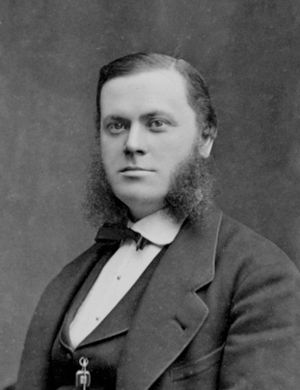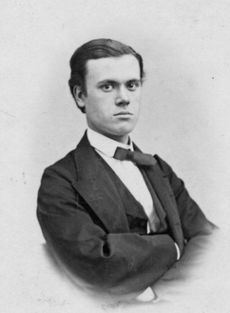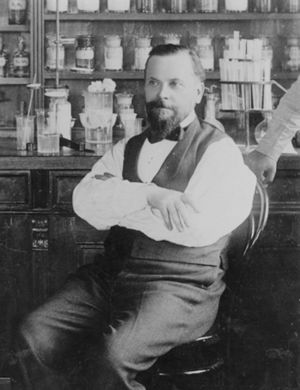Per Teodor Cleve facts for kids
Quick facts for kids
Per Teodor Cleve
|
|
|---|---|

Per Teodor Cleve, c. 1880–1890
|
|
| Born | 10 February 1840 Stockholm, Sweden
|
| Died | 18 June 1905 (aged 65) Uppsala, Sweden
|
| Nationality | Swedish |
| Alma mater | Stockholms Lyceum (1858) Uppsala University (1863) |
| Known for | discovery of holmium and thulium |
| Spouse(s) |
Carolina Alma Öhbom
(m. 1874) |
| Children | Astrid Cleve Agnes Cleve-Jonand Célie Brunius |
| Awards | Davy Medal (1894) |
| Scientific career | |
| Fields | Chemistry, geology |
Per Teodor Cleve (born February 10, 1840 – died June 18, 1905) was a Swedish scientist. He was a chemist, biologist, mineralogist, and oceanographer. He is most famous for finding the chemical elements holmium and thulium.
Cleve was born in Stockholm in 1840. He earned his science and PhD degrees from Uppsala University. This was in 1863 and 1868. After his PhD, he became an assistant chemistry professor. Later, he became a full professor of chemistry. In 1874, he thought that didymium was actually two different elements. This idea was proven true in 1885. That's when Carl Auer von Welsbach found neodymium and praseodymium.
In 1879, Cleve discovered holmium and thulium. He also found special chemicals called aminonaphthalenesulfonic acids. These are sometimes called Cleve's acids. From 1890, he focused on studying living things. He found a way to figure out the age of rock deposits. He did this by looking at tiny diatom fossils inside them. He also wrote an important book about oceanography. He passed away in 1905 when he was 65 years old.
Contents
Early Life and Education
Per Teodor Cleve was born in Stockholm, Sweden. He was the thirteenth child of his father, Fredrik Theodor Cleve, who was a merchant. His family came from western Germany and moved to Sweden in the late 1700s.
From a young age, Cleve was very interested in natural science and natural history. He went to the Stockholms Lyceum in 1858. There he studied chemistry and biology. He earned a Bachelor of Science degree from the Uppsala University in 1863. He then received his PhD from the same university in 1868.
A Career in Science
In 1860, when Cleve was 20, he became an assistant professor of mineralogy. This was at the Uppsala University. In 1868, he was made an assistant professor of chemistry. He also taught at the Royal Institute of Technology from 1870 to 1874. Eventually, he became a professor of general and agricultural chemistry at Uppsala University. He became the head of the chemistry department there in 1874. He also served as the president of the Nobel Committee for Chemistry.
Cleve's first scientific paper was about compounds of ammonia and chromium. He also wrote many other papers on complex chemical compounds. These included compounds of platinum. Cleve even made hundreds of different complex platinum compounds himself.
In the 1860s, Cleve visited many laboratories. He traveled to England, France, Italy, and Switzerland. In Paris, he visited the lab of Charles-Adolphe Wurtz. He also made many friends there.
Cleve worked on making complex chemical compounds until 1872. In 1874, he suggested that the element didymium was actually made of two elements. This idea was proven correct in 1885. That's when Carl Auer von Welsbach found praseodymium and neodymium. In 1879, Cleve showed that the new element scandium was one that Dmitri Mendeleev had predicted. Mendeleev had called it "eka-boron." Cleve was able to get some scandium that year. He also figured out its atomic weight.
He discovered the element holmium in 1879. He found it while looking at a sample of erbium oxide. As he cleaned the erbium oxide, he found a brown substance and a green substance. The brown substance was holmium oxide. The green substance was thulium oxide. He also separated thulium from an erbium oxide sample in 1879. Later, in 1895, Cleve and Abraham Langlet found helium in a mineral called cleveite.
Cleve discovered six different forms of dichloronaphthalene. He also found aminonaphthalenesulfonic acids, which are sometimes named after him. He also made several nitrosulfonic acids. In 1883, Cleve was the first person to describe a type of plankton called Nitzschia seriata. In 1890, Cleve started to focus mostly on biology. He studied freshwater algae, diatoms, and plankton. Cleve went on a Swedish trip to Spitsbergen in 1898. On this trip, he found many new types of tiny sea creatures.
Cleve worked with Otto Höglund. Together, they made many new salts of yttrium and erbium. They also studied the chemistry of thorium and lanthanum. By 1874, Cleve found that thorium was a quadrivalent element. This means it can form four chemical bonds. He also found lanthanum to be trivalent, meaning it forms three bonds. Other scientists at first doubted these findings.
Cleve was the first to see isomerism in platinumamine compounds. This means he saw that these compounds could have the same atoms but arranged differently.
Cleve also created a way to date old rock layers. These layers were formed during and after the ice ages.
Cleve's PhD paper was called "Mineral-analytiska under-sökningar." He wrote a paper about samarium in 1879. In 1900, he wrote "The Seasonal Distribution of Atlantic Plankton Organisms." In 1883, he published "Kemiskt Handlexicon," which means "Chemical Handbook." Some of Cleve's famous students include Ellen Fries, who was the first Swedish woman to get a PhD. Another student was Svante Arrhenius, who won a Nobel Prize.
Cleve also studied hydrography (the study of water) and geology (the study of Earth's rocks and soil).
Family and Later Life
In 1874, Cleve married Carolina Alma Öhbom, who was a teacher and writer. She was known as Alma Cleve. They had three daughters. Their first daughter, Astrid Maria Cleve (born in 1875), became a botanist. Cleve's son-in-law and grandson, Hans von Euler-Chelpin and Ulf von Euler, both won Nobel Prizes. Cleve was good friends with Thomas Edward Thorpe.
His second daughter, Agnes Cleve-Jonand (born 1876), was an artist. She was a pioneer of Modernism in Sweden. The third daughter, Célie Brunius (born 1882), became a journalist.
Per Teodor Cleve believed in women's equality. He supported women having the same opportunities as men. Ellen Fries, the first Swedish woman to get a PhD, was one of his students.
Cleve became sick with pleurisy in December 1904. This illness affected his heart. He thought he had gotten better by the spring of 1905. He returned home to Uppsala, Sweden. But he passed away there on June 18, 1905.
Awards and Recognition
Cleve became a member of the Royal Swedish Academy of Sciences in 1871. He received a Davy Medal in 1894. This is a very important award in chemistry.
The mineral cleveite is named after Per Teodor Cleve.
See also
 In Spanish: Per Teodor Cleve para niños
In Spanish: Per Teodor Cleve para niños



